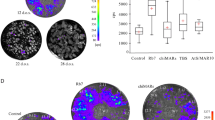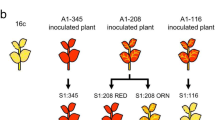Abstract
Previous work has shown that two homologous, unlinked transgene loci can interact in plant nuclei, leading to non-reciprocal trans-inactivation and methylation of genes at one locus. Here, we report the structure and methylation of different transgene loci that contain the same construct but are variably able to inactivate and methylate a partially homologous, unlinked target locus. Silencing loci comprised multiple, methylated copies of the transgene construct, whereas a non-silencing locus contained a single, unmethylated copy. The correspondence between strength of silencing activity and copy number/degree of methylation was further demonstrated by producing novel alleles of a strong silencing locus: reducing the transgene copy number and methylation within this silencing locus decreased its ability to inactivate the target locus. The strong silencing locus, which was located close to a telomere, trans-inactivated various structural variants of the original target construct, regardless of their location in the genome. This suggests that the silencing locus can scan the entire genome for homologous regions, a process possibly aided by its telomeric location. Our data support the idea that epistatic trans-inactivation of unlinked, homologous transgenes in plants results from a pre-existing epigenetic difference between transgene loci, which is subsequently equalized by “epigene conversion” involving DNA-DNA pairing.
Similar content being viewed by others
References
Ambros PF, Matzke AIM, Matzke MA (1986) Localization of Agrobacterium rhizogenes T-DNA in plant chromosomes by in situ hybridization. EMBO J 5:2073–2077
Assaad FF, Tucker KL, Signer ER (1993) Epigenetic repeat-induced gene silencing (RIGS) in Arabidopsis. Plant Mol Biol 22:1067–1085
Bird A (1992) The essentials of DNA methylation. Cell 70:5–8
Bollmann J, Carpenter R, Coen ES (1991) Allelic interactions at the nivea locus of Antirrhinum. Plant Cell 3:1327–1336
de Carvalho F, Gheysen G, Kushnir S, Van Montagu M, Inzé D, Castresana C (1992) Suppression of β-glucanase transgene expression in homozygous plants. EMBO J 11:2595–2602
Cullis CA (1986) Phenotypic consequences of environmentally induced changes in plant DNA. Trends Genet 2:307–309
Deroles SC, Gardner RC (1988) Analysis of T-DNA structure in a large number of transgenic petunias generated by Agrobacterium-mediated transformation. Plant Mol Biol 11:365–377
Dreesen TD, Henikoff S, Loughney K (1991) A pairing-sensitive element that mediates trans-inactivation is associated with the Drosophila brown gene. Genes Dev 5:331–340
Gill KS, Gill BS, Endo TR (1993) A chromosome region-specific mapping strategy reveals gene-rich telomeric ends in wheat. Chromosoma 102:374–381
Gruenbaum Y, Cedar H, Razin A (1982) Substrate and sequence specificity of a eukaryotic DNA methylase. Nature 295:620–622
Haber JE, Leung W-Y, Borts RH, Lichten M (1991) The frequency of meiotic recombination in yeast is independent of the number and position of homologous donor sequences: implications for chromosome pairing. Proc Natl Acad Sci USA 88:1120–1124
Hagemann R (1969) Somatic conversion (paramutation) at the sulfurea locus of Lycopersicon esculentum Mill. III. Studies with trisomics. Can J Genet Cytol 11:346–358
Hellmann-Blumberg U, McCarthy Hintz MF, Gatewood JM, Schmid CW (1993) Developmental differences in methylation of human Alu repeats. Mol Cell Biol 13:4523–4530
Hobbs SLA, Warkentin TD, DeLong CMO (1993) Transgene copy number can be positively or negatively associated with transgene expression. Plant Mol Biol 21:17–26
Jones JDG, Gilbert DE, Grady KL, Jorgensen RA (1987) T-DNA structure and gene expression in petunia plants transformed by Agrobacterium tumefaciens C58 derivatives. Mol Gen Genet 207:478–485
Jorgensen R (1990) Altered gene expression in plants due to trans interactions between homologous genes. Trends Biotechnol 8:340–344
Jorgensen R (1992) Silencing of plant genes by homologous transgenes. AgBiotech News Inform 4:265N-273N
Kooter JM, Mol JNM (1993) Trans-inactivation of gene expression in plants. Curr Opinion Biotechnol 4:166–171
van der Krol AR, Mur LA, Beld M, Mot JNM, Stuitje AR (1990) Flavonoid genes in petunia: addition of a limited number of gene copies may lead to a suppression of gene expression. Plant Cell 2:291–299
Lebel EG, Masson J, Bogucki A, Paszkowski J (1993) Stress-induced intrachromosomal recombination in plant somatic cells. Proc Natl Acad Sci USA 90:422–426
Lima-de-Faria A, Mitelman F, Blomberg J, Pfeifer-Ohlsson S (1991) Telomeric location of retroviral oncogenes in humans. Hereditas 114:207–211
Linn F, Heidmann I, Saedler H, Meyer P (1990) Epigenetic changes in the expression of the maize A1 gene in Petunia hybrida: role of numbers of integrated gene copies and state of methylation. Mol Gen Genet 222:329–336
Matzke M, Matzke AJM (1993) Genomic imprinting in plants: parental effects and trans-inactivation phenomena. Annu Rev Plant Physiol Plant Mol Biol 44:53–76
Matzke MA, Primig M, Trnovsky J, Matzke AJM (1989) Reversible methylation and inactivation of marker genes in sequentially transformed tobacco plants. EMBO J 8:643–649
Matzke MA, Neuhuber F, Matzke AJM (1993) A variety of epistatic interactions can occur between partially homologous transgene loci brought together by sexual crossing. Mot Gen Genet 236:379–386
Matzke M, Matzke AJM, Mittelsten Scheid O (1994) Inactivation of repeated genes — DNA-DNA interaction? In: Paszkowski J (ed) Homologous Recombination in Plants. Kluwer, Amsterdam, pp 271–307
Meyer P, Heidmann I, Neidenhof I (1993) Differences in DNA-methylation are associated with a paramutation phenomenon in transgenic petunia. Plant J 4:89–100
Mittelsten Scheid O, Paszkowski J, Potrykus I (1991) Reversible inactivation of a transgene in Arabidopsis thaliana. Mol Gen Genet 228:104–112
Patterson G, Thorpe CL, Chandler VL (1993) Paramutation, an allelic interaction, is associated with stable and heritable reduction of transcription of the maize b regulatory gene. Genetics 135:881–894
Pröls F, Meyer P (1992) The methylation patterns of chromosomal integration regions influence gene activity of transferred DNA in Petunia hybrida. Plant J 2:465–475
Rhounim L, Rossignol JL, Faugeron G (1992) Epimutation of repeated genes in Ascobolus immersus. EMBO J 11:4451–4457
Rossignol JL, Faugeron G (1994) Gene inactivation triggered by recognition between DNA repeats. Experientia 50:307–317
Sabl JF, Laird CD (1992) Epigene conversion: a proposal with implications for gene mapping in humans. Am J Hum Genet 50:1171–1177
Saccone S, Sario AD, Valle GD, Bernardi GD (1992) The highest gene concentrations in the human genome are in telomeric bands of metaphase chromosomes. Proc Natl Acad Sci USA 89:4913–4917
Sandell LL, Zakian VA (1992) Telomeric position effect in yeast. Trends Cell Biol 2:10–14
Selker EU (1990) Premeiotic instability of repeated sequences in Neurospora crassa. Annu Rev Genet 24:579–613
Stock C, Ambros IM, Mann G, Gadner H, Amann G, Ambros P (1992) Detection of Ip36 deletions in paraffin sections of neuroblastoma tissues. Genes Chrom Cancer 5:1–9
Vaucheret H (1993) Identification of a general silencer for 19S and 35S promoters in a transgenic tobacco plant: 90 by of homology in the promoter sequence are sufficient for inactivation. CR Acad Sci [III] 316:1471–1483
Wessler SR (1988) Phenotypic diversity mediated by the maize transposable elements Ac and Spm. Science 242:399–405
Author information
Authors and Affiliations
Additional information
Communicated by H. Saedler
Rights and permissions
About this article
Cite this article
Matzke, A.J.M., Neuhuber, F., Park, Y.D. et al. Homology-dependent gene silencing in transgenic plants: epistatic silencing loci contain multiple copies of methylated transgenes. Molec. Gen. Genet. 244, 219–229 (1994). https://doi.org/10.1007/BF00285449
Received:
Accepted:
Issue Date:
DOI: https://doi.org/10.1007/BF00285449




